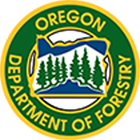Water Trees Deeply as Mercury Climbs
The weather forecast is calling for high temperatures around most of the state through the weekend and even into the middle of next week. It’s a time to keep fire prevention uppermost in our minds, and also, to remember to protect the health of trees in yards and landscapes by deeply watering them.
“Summer temperatures can be hard on trees, especially landscape trees in our urban areas,” says Kristin Ramstad, an urban forester with the Oregon Department of Forestry. “If they aren’t well-watered, warm weather and prolonged drought eventually make trees more susceptible to insect and disease problems,” adds Ramstad.
Seems like a good time to remember that when temperatures in Oregon get warm and stay warm, it can take a toll on trees as well as people. The Oregon Department of Forestry suggests a few tips for keeping your trees healthy during times of heat stress.
Symptoms of drought
One of the first signs that a deciduous tree (i.e., trees like birches or maples that drop leaves in the winter) needs water is that its leaves begin to look dull, and sometimes, limp.
More advanced symptoms of needing water are browning of leaves, wilting, and curling at the edges. Leaves may also develop a scorched or burned look, turning yellow or brown on outside edges, or between leaf veins. Leaves may even appear smaller than usual, drop prematurely, or turn brown but remain on the tree.
When drought-stressed, the needles of conifers (evergreen trees such as Ponderosa Pine or Douglas-fir) may turn yellow, red, purple or brown.
Watering tips
Given their benefits, longevity, and contributions to the environment, give your trees higher watering priority than lawns. Keep in mind that if trees are only provided with shallow water every so often, they’re probably only getting a fraction of what they need. Watering trees for short periods of time encourages shallow rooting, which can lead to future health problems for the tree.
To make sure your tree gets the water it needs, saturate the soil within the drip line – that’s the circle that could be drawn on the soil around the tree directly under the tips of its outermost branches. Using a regular hose or a soaker hose, water deeply and slowly – slowly is important, so the water doesn’t run-off. To make sure it gets enough water, keep moving the hose around different areas under the tree.
For conifers, water 3 to 5 feet beyond the drip line on all sides of the tree. Also, if you have a choice, water trees during the cooler part of the day. Another way to water trees slowly is to put a nail hole in the bottom (near the edge) of a five gallon bucket. Fill the bucket with water, and leave the slowly leaking bucket under the canopy of the tree. Do this twice or three times per tree, moving the bucket each time.
Other tips: Use mulch
Using mulch is an excellent way to care for trees in warm weather, as it helps the soil below trees retain moisture and stay cool. Mulch can be made of bark, wood chips, leaves and evergreen needles.
Apply mulch within the drip line, at a depth of four inches, leaving a six-inch space between the mulch and tree trunk. Mulch will also help discourage weeds.
Lastly, don’t plant annual flowers or other groundcovers under the canopy of your tree, as they’ll compete with the tree’s roots for moisture and nutrients.
Good tree care = a good investment
Trees and forests enhance quality of life in many ways, providing shade, wildlife habitat, clean air, wood and other products, raising property values, and providing clean, healthy streams.
What’s more, on hot days, we all rely on the shade of the trees in our yards and communities. Therefore, it is a really good idea to keep our trees healthy and watered.
For more information about trees and tree care:
www.isa-arbor.com/
www.treesaregood.com/treecare/treecareinfo.aspx
